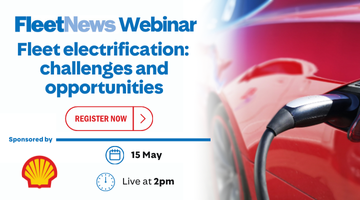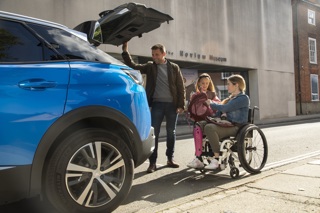Grappling with the transition to electric, vehicle supply shortages and rising prices? Spare a thought for Andrew Miller (pictured).
Chief executive at Motability Operations for the past 20 months, he oversees the biggest fleet in the UK, purchasing, converting and disposing of more than 630,000 vehicles.
Motability Operations accounts for 12% of annual new car registrations and is the country’s highest spender in the conversion and repair markets, as well as being one of its biggest insurers. Fleet issues are multiplied exponentially at this scale.
For more than 40 years, the organisation has managed the Motability Scheme on behalf of charity Motability, which is both customer and regulator. The relationship is founded on fleet dynamics and a customer service proposition, with Miller counting both the charity and the car drivers as his customers.
“My most important goal is to carry on doing what we’ve always done and that’s to provide amazing customer service,” Miller says on a Teams call with Fleet News.
The Motability proposition is to offer eligible drivers a complete bundled service which covers the car, insurance, breakdown, home charger if required, maintenance and repair, tyres and the car adaptations. It also supports individuals if new circumstances mean they need to change or amend their car.
“It’s a huge remit of services and we’ve got to make sure they are all still relevant,” Miller says.
Grappling with the transition to electric, vehicle supply shortages and rising prices? Spare a thought for Andrew Miller (pictured).
Chief executive at Motability Operations for the past 20 months, he oversees the biggest fleet in the UK, purchasing, converting and disposing of more than 630,000 vehicles.
Motability Operations accounts for 12% of annual new car registrations and is the country’s highest spender in the conversion and repair markets, as well as being one of its biggest insurers. Fleet issues are multiplied exponentially at this scale.
For more than 40 years, the organisation has managed the Motability Scheme on behalf of charity Motability, which is both customer and regulator. The relationship is founded on fleet dynamics and a customer service proposition, with Miller counting both the charity and the car drivers as his customers.
“My most important goal is to carry on doing what we’ve always done and that’s to provide amazing customer service,” Miller says on a Teams call with Fleet News.
The Motability proposition is to offer eligible drivers a complete bundled service which covers the car, insurance, breakdown, home charger if required, maintenance and repair, tyres and the car adaptations. It also supports individuals if new circumstances mean they need to change or amend their car.
“It’s a huge remit of services and we’ve got to make sure they are all still relevant,” Miller says.
“It’s about how we shape our proposition in a world where there’s less availability and higher pricing.”
Ah, availability – the most immediate and pressing challenge facing fleet operators. Across the sector, it is affecting speed of transition to electric as well as resulting in a rise in both new and used car prices.
Lack of supply caused Motability’s annual purchases to drop by 8% last year. They are down a further 21% in the first half of this year, equating to more than 22,000 cars.
“We are benefiting strongly from the increase in used car prices; we fund our cars, so this benefits our profit line,” Miller says.
“But the big problem is availability and, indirectly, the pricing of new cars, which is making it harder to find affordable cars.”
He adds: “From the conversations I have, I think it will still be a year and a bit before supply comes back.”
Motability Operations has reacted to the supply shortages by automatically extending leases beyond its standard three-year/60,000-mile contract. More than 100,000 cars are currently on an extended lease with the majority on a six-to-nine-month extension.
From a residuals point of view, this will be relatively easy to absorb as the cars tend to have lower annual mileage and values remain high. Motability Operations manages the remarketing process via its in-house MFL Direct division giving it robust controls over how cars return to market (the majority go via the franchised network).
In addition, Covid-19 restrictions led to reduced use by customers resulting in lower insurance claims and less wear and tear. As a result, during 2020 and 2021, Motability Operations sent two £50 rebates to customers followed by a third, £60, rebate.
Interestingly, Miller is not advocating customers begin their planning cycle earlier to counter the long delivery times.
“We try, from our perspective, to not have big spikes unnecessarily in volume; the main thing is to fulfil the orders that are in place. So, we are encouraging customers to work the way they always have done and place orders as they get towards the end of their leases,” he explains.
“However, it’s clear the choice of cars for customers will be less for a period of time, so we are looking at ways of supporting that.”
The fleet is now, effectively, operating on a 3.5-year cycle, which could be a sign of things to come as more electric vehicles are added, according to Miller.
“We are looking at the cycle for electric vehicles, but we don’t have enough history yet to be able to figure whether the residual values are different,” he says. “Logically, one would argue that the leases should be longer, but how that manifests itself in the back-end lease economics, we’ve not yet figured out.
“On the other side, you have things like differential wear on the front and back tyres, so we’re working with Kwik Fit on a different service offering around actively managing the tyre wear so we’re not replacing four at one time.”
Managing the transition to electric is a major priority for the organisation. A couple of years ago, demand soared for plug-in hybrid; now the emphasis is on full battery electric (BEV). Around 5% of the fleet is BEV, but it accounts for 15% of applications.
Here, the pricing issue becomes even more pertinent. Miller points to the general rise in prices through a lack of supply plus the differential pricing which adds a premium of £10,000-£15,000 per EV. And then there is the third whammy from the Government’s removal of subsidies.
“Our customers’ income is capped to some extent, so we are not able to pass (price) inflation back to them; we have to find a way to optimise the economics for our customer,” Miller says.
“Do we have to modify our products to make sure our customers are getting a car at the right price? Do we have to modify the lease dynamics? Or do we have to build our electric leases in a different way so that we can justify pricing at a lower front end for the customer?”
Adding to those future leasing dynamics is vehicle to grid (V2G). Motability Operations has selected Easee and Ohme as its charging providers partly because their technology allows for V2G.
“That’s really interesting territory,” Miller says, “because you get into the value of the lease being as much about the electricity value which could change the lease dynamics.
“That’s probably five, six, seven years away but it opens the question of what is the car more important to – a leasing proposition or an energy storage proposition? That has profound implications for the entire fleet industry.”
Miller’s biggest EV concern is for the 33,000-plus wheelchair accessible vehicles (WAVs); these individuals are at greatest risk of being left behind on the journey to electric, he claims.
In addition to the pricing woes, converters are unable to drop the floor of the car to improve accessibility due to the battery location while the modifiers can’t adapt the electrics because of the sophistication of the systems.
Then there is the lack of accessibility for wheelchair users at public charging points (see Zap-Map trial below); a similar challenge, in fact, to that facing van drivers.
“Our WAV customers require the most support for these vehicles. For many, the car is their lifeline to get around, but they risk being left behind,” Miller says.
“Design should be led by solving the most complex and unique solutions. We (the industry) haven’t done that here, it’s been the usual mistake of rushing something out without thinking it through.”
His parting shot is a plea for greater collaboration: “The only way this will be resolved is for all the parties – government, OEMs, converters, adapters, us and the Motability charity - to come together to find the solutions.”
TESTBED FOR EV INNOVATIONS
With such a vast fleet, Motability Operations is a perfect partner to trial innovations in the electric marketplace.
“You learn the most by working with early-stage companies,” Andrew Miller says. “The beauty is if it works well, we have scale to help them scale their business in the right way. That’s the premise of what we’ve been doing; looking at problems to solve – not just for our customers, but for everyone.”
Bonnet
Motability customers have been trialling Bonnet’s charging app which connects 17 EV charging networks in Europe. Users access one app, with one account and one nationwide fee for all networks, with the only pricing differential on the speed of charging.
Co Charger
In this three-month pilot, a selection of Motability customers are engaging with Co Charger's community of privately-owned chargers, effectively an ‘Airbnb’ for charging. Co Charger connects ‘hosts’ across the UK who have home chargers to other motorists, who do not have off-street parking, or the facilities at home to install a charger. “It’s a booking system and it works well,” says Miller. “We are also looking at trials with a couple of councils to find charging solutions for terraced houses.”
Zap-Map
Hundreds of Motability Scheme customers are trialling the Zap-Map app with a view to building an understanding levels of accessibility levels across the UK public charging network.
Charge Fairy
In this pilot, Motability customers have been using Charge Fairy’s mobile electric car charging service. The technology monitors a customer’s charge level remotely, and when it drops below a certain point, a Charge Fairy van visits the customer’s car, wherever it is parked, and charges it.
“The trial showed it’s uneconomic to scale, but the remote monitoring software is really helpful and is something we might look to leverage more,” Miller says. “We also introduced them to one of our partners, the RAC, for motorway recovery.”
Login to continue reading.
This article is premium content. To view, please register for free or sign in to read it.





















Login to comment
Comments
No comments have been made yet.